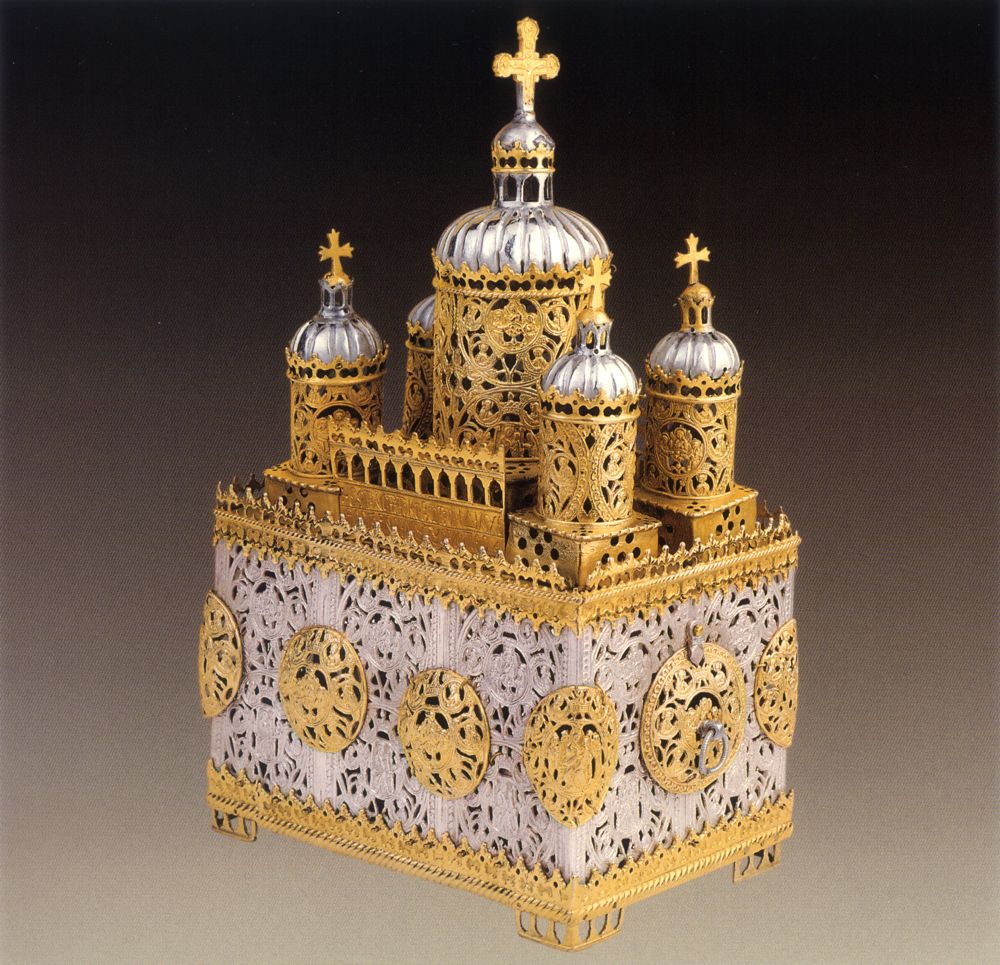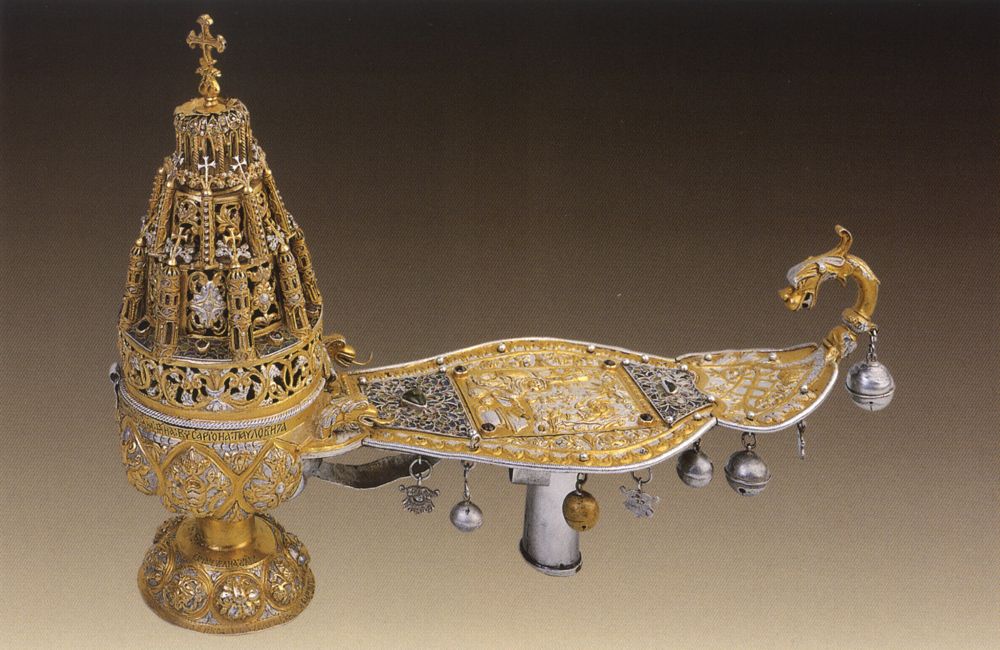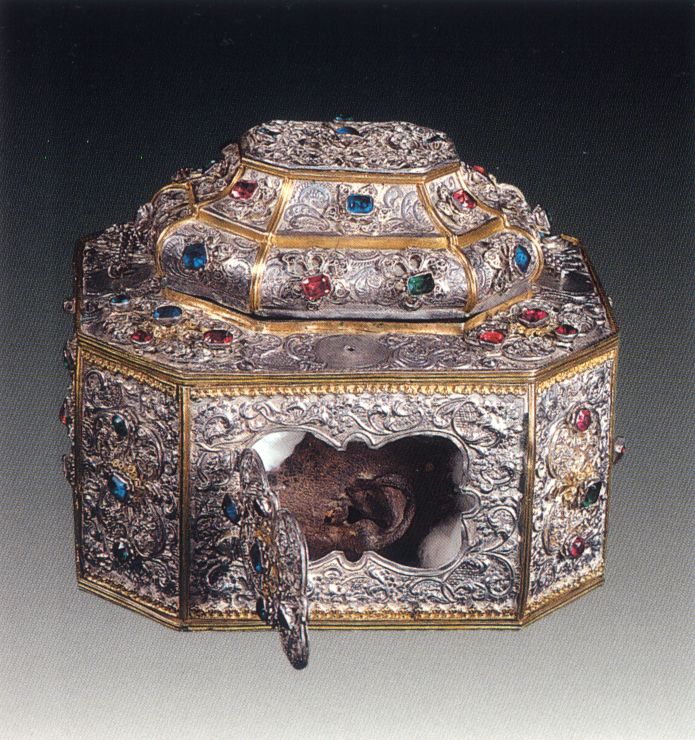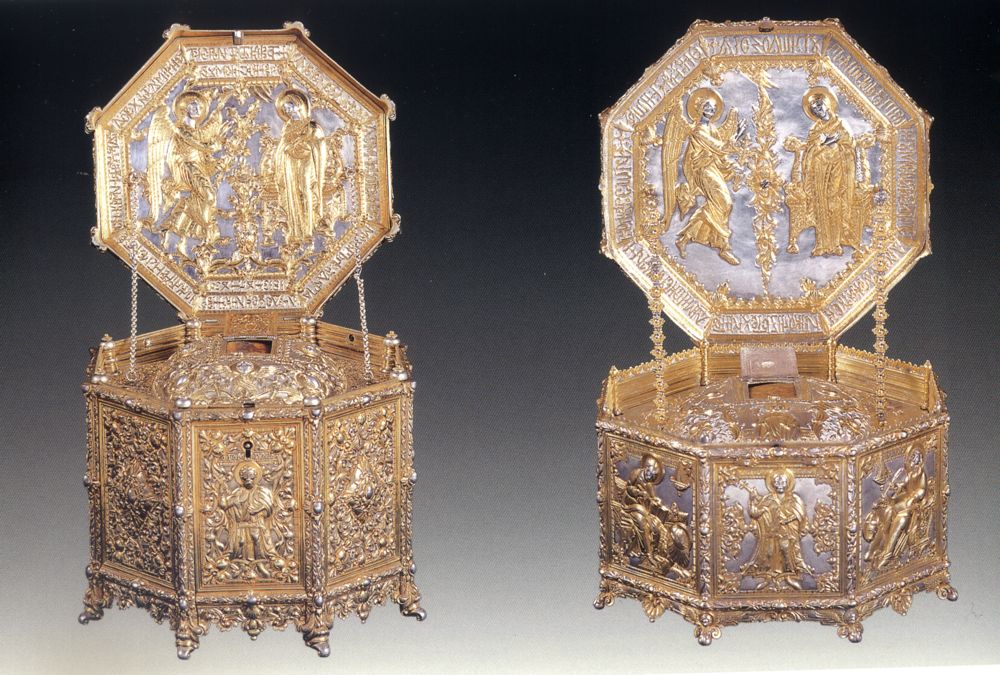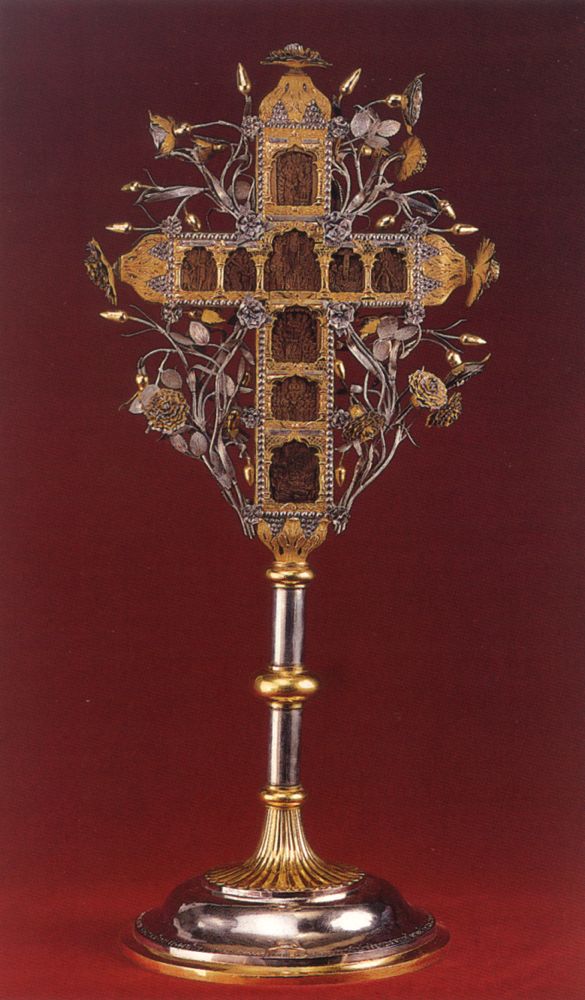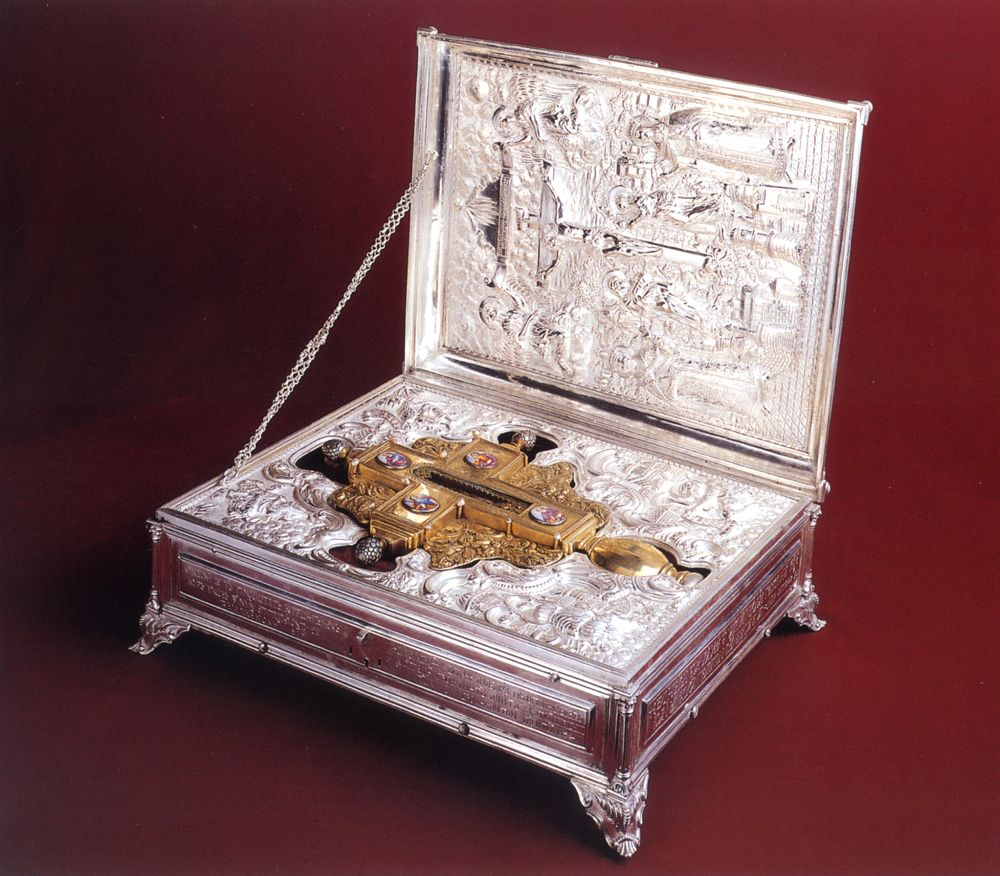Greek Workshops and Itinerant Craftsmen from 18th & 19th centuries
17 December 2015The offerings of the 18th century in the Vatopaidi sacristy have varied origins and thus reflect the range of the Monastery’s influence. It is no accident that this influence is not confined to the boundaries of Greece, but includes the broad geographical area in which the Greek communities of the Ottoman period were active and flourished. From Asia Minor to the regions north of the Danube, the votive offerings reflect the steady improvement of the lot of the Greeks. The donors are no longer exclusively clergy or princes, but now include local notables and prosperous merchants. Social stratification also had its effect on craftsmen as a class: it is now rare for important works to be unsigned.
The church-shaped casket (kivotion) of 1714 with its five domes is the offering of the monk Daniil and the work of Gerasimos of Sinope.
It is made up of cast openwork parts, typical of 17th-century conical lamps. The scenes of the Hospitality of Abraham and of the Theotokos enthroned, surrounded by a winding vine with prophets, exactly as on panaghiaria, are repeated on the vertical sides, on the drums of the domes, and on the hemispherical features of the casket. Similar decoration is to be found on a series of oil-lamps in the sacristy of the Detchani Monastery in Kossovo, which are rightly regarded as routine productions, intended for general consumption. However, in the case of the casket in the Vatopaidi Monastery, the work is carefully executed, clearly because it is meeting an order which made specific demands. The origins of the craftsman are of particular interest, given that we know that there are other works by goldsmiths from Sinope on the Holy Mountain. Furthermore, it appears that Gerasimos of Sinope is the same craftsman who, as the monk Gerasimos, worked on Patmos and signed in 1685 a multiple oil-lamp, a polykandelon, in the Monastery of St John. At the same time, the works which have survived from the churches of Sinope point to a local tradition in silverwork, the result of the exceptional development which the city enjoyed as the main port of the Ottoman Empire on the Black Sea until the 19th century69. It is important to note that the goldsmiths of Sinope evolved within the framework which we know applied in the case of other Asia Minor craftsmen, of Pontic or Karamanli origin, who worked seasonally or established themselves for a certain space of time in Constantinople to practise their craft.
It is into a purely Asia Minor atmosphere which we carried by the chalice of 1750, which, by what means is not known, has found its way into the Vatopaidi sacristy though the “PROPERTY OF ST NICHOLAS OF TOKAT BY THE PROVIDENCE OF THE ALL-VENERABLE BISHOP OF NEOCAESAREA DOMINUS KYR COSMAS”.
Of large size with a cover, overloaded, jewelled and of a curious shape, the chalice has, in spite of everything, a simple charm and can be regarded as characteristic of the Asia Minor region in general. Older chalices with inscriptions in Armenian, Greek or Karamanli all have a sui generis shape, but the closest of all these to our example and without doubt a product of the same workshop is the chalice of 1751 from Kermira, a village of importance in the Caesarea region. Some of the features of both examples, such as the shaping of the foot into two lobed levels or the enclosed cylindrical core, are even reminiscent of the Late Gothic origins of the type. On the other hand, the spirit of the age is reflected in the large filigree knobs, adorned with granules and nail-heads, the floral decoration and the dense iconography – chiefly busts of apostles, prophets and angels, the Deisis, and the Crucifixion.
From the other geographical extreme – the regions north of the Danube – are two katzia of 1735 and 1737, striking because of their particularly long handles, and made by the goldsmith Georghis Vrysas.
A katzion is a censer with a large broad handle, rather than chains, on which the saint to whom the church is dedicated is usually depicted – in the present case the scene is the Annunciation of the Blessed Virgin, to which the katholikon of Vatopaidi is dedicated.
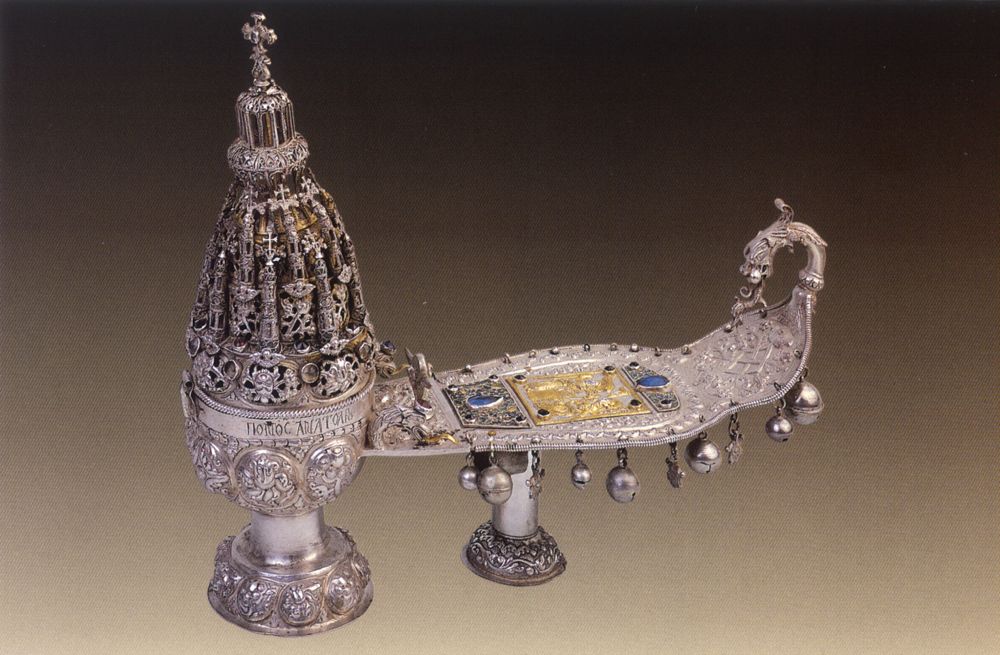
The receptacle with the foot and the high architectural cover, with what are now degenerate Late Gothic features, follow the familiar type of censers with chains. Particular emphasis is, however, given to the handles. They are in the shape of a large leaf folded back on itself at the tip and ending in a cast dragon’s head. At the point where it joins the receptacle, there are two more cast dragons, while small bells hang from below. Repoussé plaques with the scene of the Annunciation, a different one on each katzion, have been nailed on to the handle and are framed by two more nailed-on plaquettes, which are adorned with filigree enamel and large coloured stones in high-collar settings. The rest of the decoration, gilt on a silver stippled background, is derived from the type of floral baroque which we have seen on the casket and the repository of the skull of St Gregory the Theologian, and is extremely common in the silverware of the 18th century. The inscription, in Slavonic, tells us that this is an offering of Vissarion Pavlovich, Bishop of Batchka, Szeged and Itsar, while below the base we have the Greek signature of the goldsmith. The Batchka region is in Voivodina, north-west of Belgrade, while the Hungarian city of Seged was the gateway to the interior of Hungary, and thence to Vienna. Already at the time, under the crown of the Hapsburgs, these territories were traversed by the “conquering Orthodox Balkan merchant”, in the classic phrase of Stoianovich, and had concentrations of Serb and Greek emigrés. The latter, chiefly Western Macedonians and Epirots, were renowned for their specialisation in silversmithing.
The other end of the commercial routes, the place of origin of a considerable number of Western Macedonian immigrants – Siatista – was the native place of the donor of the casket for the skull of St Andrew the Cretan of Jerusalem, “at the expense of the honourable lord ioannis son of const[antine] koyopoulos”, while as to the maker, the inscription has “by the hand of constantine goldsmith”.
The casket, however, would seem to contain the skull of St John Chrysostom, a change which, according to tradition, took place on an alms mission of Vatopaidi monks to Russia in the 17th century. Tightly-knit filigree stems with a vine in granules are combined with the repoussé parts of the casket, which have rococo scrolls and baroque grids. A suggestion of luxury is achieved by the use of glittering glass paste stones. There is a similar casket, containing the skull of St Charalampus in the Monastery of St Stephen at Meteora.
The craftsmen who produced two similar casket-reliquaries dated 1813 and 1818 were from Nikolitza, the place of origin of the goldsmith Nikolaos, who in 1690 made the revetment for the Vematarissa icon.
The inscriptions give the makers as “DIMITRI AND NAOUM FROM NIKOLIZA”, and we are told that the casket was made “AT THE EXPENSE OF THE ALL-VENERABLE ABBOT OF VATOPEDI KYR MAKARIOS OF NIKOLIZA”. The casket of 1818 contains the skull of St Mercurius and “WAS MADE BY CONTRIBUTIONS FROM KORIZA AND MOSCHOPOLIS”, while that of 1818 has in it the skull of St Florus. Of the two craftsmen, Dimitris must have been the elder and Naoum his apprentice. The latter seems to have worked on the Holy Mountain again in the period 1853-63 and signed his works as Naoum, Nikolaos. On the interior of the lid of both reliquaries the Annunciation of the Blessed Virgin Mary is depicted in a similar manner. With the minor differences appropriate, St Mercurius and St Florus, with the cross of martyrdom in their hands, are shown on the front panel of the octagonal caskets. This is not, however, the familiar iconography of St Mercurius, who is normally depicted as a beardless warrior saint wearing a curious helmet. Empty cartouches, sea-shells, and dense foliage arranged symmetrically cover the other sides of the casket of St Mercurius, while on that of St Florus, three six-winged seraphim and the four Evangelists with their symbols are depicted in the way in which they normally appear on Gospels covers.
An exceptionally well-fashioned benediction cross “BY THE HAND OF NIKOLAOS KERTZOS OF KALARYTES IN THE YEAR 1789” may be added to the series of known works produced by renowned Epirot goldsmiths from Kalarrytes.
The framework within which the Vlach-speaking villages of the Pindus Mountains – Syrrako, Kalarrytes, and Metsovo – evolved is similar to that of the villages of Moschopolis, with shepherds, muleteers and merchants operating both at the local level and throughout the Balkans. Specialisation in silversmithing completes the picture. The mounting of the carved wooden cross is made of fine filigree decoration with spiralling detail combined with filigree and painted enamel, the latter to stress the full-relief tulips and the palmettes which spring from the sides of the cross. Scattered pearls and coloured stones in high-collar settings give an initial impression of the aesthetic known to us from Constantinopolitan works and their derivatives of the late 17th century. The differences here are, nonetheless, definitive. The large three-petalled or heart-shaped flowers of filigree enamel are radically different from the filigree floral enamel of the 17th and early 18th centuries, while at the base of the cross the goldsmith from Kallarytes has sought to render the decoration in three dimensions: daisies with petals of filigree enamel and stamens of granules stand out from the filigree and granular flowers, constructed on two or three levels.
The large-size carved wooden cross with a silver and gilt mounting is probably the work of the same craftsman.
The inscription states that it was dedicated in 1811 to the Vatopaidi Monastery by the guild of goldsmiths of Thessaloniki – “THE HAND OF NIKOLAOS OF KALARYTES AND HIS PUPIL IOANNIS”. Clearly the Kallarytes goldsmith was a distinguished member of the Thessaloniki goldsmiths’ guild if he was entrusted with the execution of their collective offering. The carved wooden depictions of the Dodekaorton, the Passion, and the Miracles of Christ are flat and compressed, while the silver stem and the base of the cross are exceptionally simple. The emphasis is on the flowers which surround the arms, and there is the clear trend, which already manifests itself in the base of the 1798 cross, for the decoration to be rendered in a realistic and three-dimensional manner. There is, however, a difference in the technique: cast pliant foliage with many-petalled flowers, buds and a host of long, narrow serrated leaves create an impression of dense vegetation.
The gospel cover in Fig. 475 is the “TOIL AND AT THE EXPENSE” of the Vatopaidi priest-monk Konstantios from Serres, dated 1802. It shares with the gospels of the time the characteristic of the prevalence of Westernised iconography, arrangement into cartouches, and the rich, almost overabundant, rococo decoration consisting of sea-shells, scrolls and flowers, chiefly roses. The iconography is that typical of gospels: the Crucifixion and the Resurrection are shown in the central medallions, with prophets and evangelists with their symbols in the corners, but it is enriched here with Christological scenes contained in the smaller medallions. The nimbuses are formed by pearls, and coloured stones adorn the back and front. The Monastery of Vatopaidi is portrayed on the lower part of the front: it is shown surrounded by a protecting wall, behind which the katholikon, the bell-tower, and the high tower with its cannons stand out. Similar iconography of the central scenes and of the prophets and evangelists in the corners can be seen on a gospel made in Smyrna in 1816, while the framing with scenes from the Passion of Christ and the Dodekaorton is encountered in a series of other Gospels of this period, coming from Asia Minor and Greece itself. This type of gospel, representative of Oriental rococo, made its appearance, as far as we know at present, after the mid 18th century and coincides chronologically with the increased prosperity of the Greek communities and with the turning of the Greek world, in terms of ideology and art, towards the models of the West.
Ainos was one of the flourishing Greek maritime cities in Thrace with an important guild organisation and goldsmiths’ workshops. A casket of 1808, which contains a benediction cross and was dedicated to the Vatopaidi Monastery with funding by citizens of Ainos, bears an exceptionally interesting inscription which provides us with a connecting link in the identification of two or possibly three successive generations of a family of goldsmiths: “THIS WAS CRAFTED BY THE HAND OF THE HUMBLE NIKOLAOS PILGRIM SON OF IOANNIS PHOKAS OF THE PELOPONNESE FROM ZATOUNA”.
We know that Ioannis, son of Nikolaos, worked on the Holy Mountain, since the silver revetment of the Axion Esti icon in Karyes “was crafted by the hand of Ioannis son of Nikolaos of Ainos in the year · [1836] in the Holy Monastery of Vatopaidi”, while three years later, in 1839, the same craftsman made the revetment for the Koukouzelissa icon at the Megiste Lavra. Nevertheless, the inscription on the casket refers emphatically to the father of Nikolaos in a way which indicates that he enjoyed a good reputation, which also reflects upon the son. Ioannis of the Peloponnese should probably be identified with the famous goldsmith whose works are to found on Patmos and cover the years from 1722 to 1753. His place of origin, Zatouna in Arcadia, produced a number of well-known painters of the 18th century who were active in the Peloponnese. However, it is unlikely that it was the place of work of Ioannis of the Peloponnese, who worked chiefly in the south-eastern Aegean area. It seems more likely that he worked at Ainos, where his family must have settled permanently after the destruction in 1770 of Zatouna by the Turco-Albanians.
The style and the quality of workmanship of the casket have no features in common with the works of Ioannis of the Peloponnese, but are directly linked with the works of the goldsmith Dimitris from Ainos, whose known works cover the period from 1773 to 1820. The Resurrection on the lid of the casket and the prophets on the inside plate with the cross-shaped opening are derived from the same iconographic models as were used on the gospel covers originating in Ainos.

